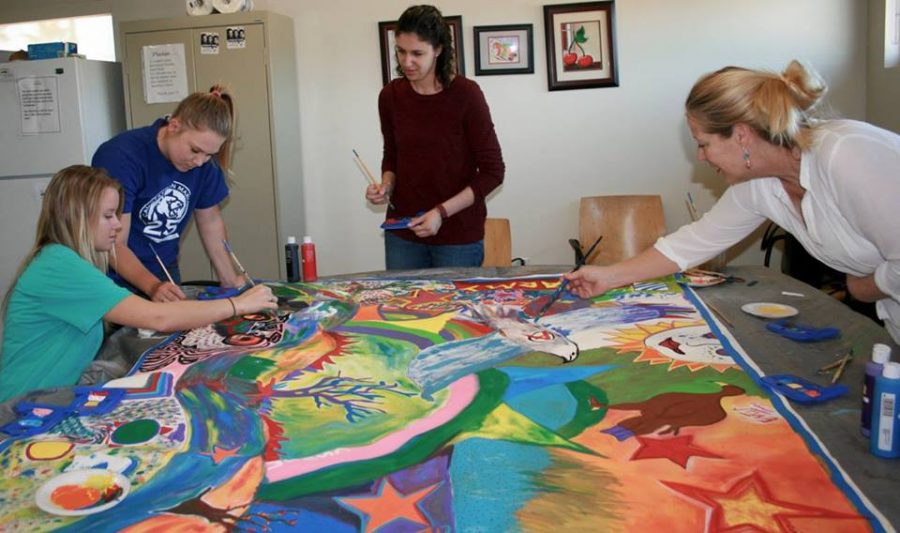Operation Art brings support to local veterans, homeless
CSUSM Human Development students (from left to right) Lauren, Nicole and Emily, and Dr. Eliza Bigham (far right) help paint a mural for Operation Art at one of their biweekly Friday meetings.
April 27, 2016
It is believed that art holds the power to heal. In Operation Art, those struggling to share their voice find comfort in art, for it allows them to express themselves in ways they never imagined.
Run by Interfaith Community Services at the Hawthorne facility, the project aims to support the homeless and veteran population. Project driver, Communication Specialist and artist/advocate Marilyn Huerta helped create the project and has partnered with CSUSM’s Dr. Eliza Bigham and Joanne Tawfilis.
To participate in research for their applied research class, Human Development 497, taught by Dr. Bigham, seniors Emily Rosenthal, Lauren Brickley and Nicole Robertson have attended sessions with the veterans and homeless of the Hawthorne facility every other Friday throughout the spring semester.
“By participating in Operation Art, my students get the chance to interact with veterans who are staying at the resource center while they transition through medical issues, housing challenges or similar situations six times during the course of the semester,” said Bigham. “I believe that having meaningful experiences with persons from populations that are different than your own, by reason of any dimension (i.e. culture, ethnicity, SES, ability, military status, etc.), helps the students to develop empathy, social responsibility, and cultural humility.”
Working with Dr. Bigham and Huerta, students encourage the clients to paint anything of their choosing on a mural. They found that many of the struggling individuals began to express a part of themselves each and every session.
“I love how the participants like to point out what they created and tell the stories about what’s behind the imagery. One speaks of imagery that depicts his military unit, whereas another tells me of a peaceful mountain landscape he painted. I love seeing the pride in their eyes as they share with me,” said Huerta.
Witnessing how much the clients find comfort in art, Rosenthal recalls how one client shared their grief through their painting.
“I have worked with a client who experienced the loss of a close family member and one day he began to paint angels that represented the person he had lost. This helped him heal emotionally by having a piece of art he made that was a constant reminder of his faith. It is important to realize that each person has unique ways of healing through art,” said Rosenthal.
Robertson adds that it’s rewarding to see how much a simple art project can lead to such happiness.
“I loved seeing a person who was once afraid to pick up a paint brush finish our two-hour session with a completed canvas. They are so excited to show people what they made,” says Robertson.
While Huerta, Bigham and students strongly believe in the power of art, they don’t see themselves as therapists.
“We stress that we are not therapists, but coach others to use art as a tool. This particular [project] is helping veterans and homeless clients to cope, communicate and connect with others. It’s also a fun activity that brings people together,” said Huerta.
Brickley reiterates that art can in fact be a powerful healing tool.
She said, “I think that people should be aware of how healing art can be when dealing with certain mental and physical issues. The art is unique to each individual because it can tell a story of what they are going through on the inside.”
With the semester coming to an end, Huerta and Bigham hope that the success of this project can not only show how art can be a powerful healing tool, but a foundation for building a positive community amongst those in need of one.
“Art gives them a voice and a project for them to focus on when reality can be difficult. By creating the mural, it provides an opportunity to feel a sense of belonging,” said Huerta.
Through this project, Bigham’s students were able to witness the power art can truly have on making a positive change in people’s lives.
“Art can improve the emotional well-being of one’s life by providing a type of therapy and self-expression that traditional ‘talk therapy’ is unable to do,” said Rosenthal. “Art gives them a way to heal without the need to speak.”
To learn more information about Operation Art and how you can be involved, contact Marilyn Huerta at [email protected] and Dr. Eliza Bigham [email protected].







VeteranAid.org • Apr 28, 2016 at 7:26 am
This is great! It’s neat to see more charities and support groups helping veterans. The Aid and Attendance benefit can also be a great help to senior veterans and their spouses who need help paying for care. I suggest the website http://www.VeteranAid.org. It tells you how to apply for the Aid and Attendance benefit and has a large amount of information regarding the benefit.